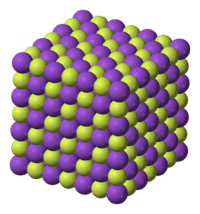Potassium fluoride
 | |
| Names | |
|---|---|
| IUPAC name
Potassium fluoride | |
| Identifiers | |
| 7789-23-3 (anhydrous) 13455-21-5 (dihydrate) | |
| 3D model (Jmol) | Interactive image |
| ChEMBL | ChEMBL1644027 |
| ChemSpider | 23006 |
| ECHA InfoCard | 100.029.228 |
| EC Number | 232-151-5 |
| PubChem | 522689 |
| RTECS number | TT0700000 |
| UNII | 9082WG1G3F |
| |
| |
| Properties | |
| KF | |
| Molar mass | 58.0967 g/mol (anhydrous) 94.1273 g/mol (dihydrate) |
| Appearance | colourless |
| Density | 2.48 g/cm3 |
| Melting point | 858 °C (1,576 °F; 1,131 K) (anhydrous) 41 °C (dihydrate) 19.3 °C (trihydrate) |
| Boiling point | 1,502 °C (2,736 °F; 1,775 K) |
| anhydrous: 92 g/100 mL (18 °C) 102 g/100 mL (25 °C) dihydrate: 349.3 g/100 mL (18 °C) | |
| Solubility | soluble in HF insoluble in alcohol |
| Structure | |
| cubic | |
| Hazards | |
| EU classification (DSD) |
Toxic (T) |
| R-phrases | R23/24/25 |
| S-phrases | (S1/2), S26, S45 |
| NFPA 704 | |
| Flash point | Non-flammable |
| Lethal dose or concentration (LD, LC): | |
| LD50 (median dose) |
245 mg/kg (oral, rat)[1] |
| Related compounds | |
| Other anions |
Potassium chloride Potassium bromide Potassium iodide Potassium astatide |
| Other cations |
Lithium fluoride Sodium fluoride Rubidium fluoride Caesium fluoride Francium fluoride |
| Except where otherwise noted, data are given for materials in their standard state (at 25 °C [77 °F], 100 kPa). | |
| | |
| Infobox references | |
Potassium fluoride is the chemical compound with the formula KF. After hydrogen fluoride, KF is the primary source of the fluoride ion for applications in manufacturing and in chemistry. It is an alkali halide and occurs naturally as the rare mineral carobbiite. Solutions of KF will etch glass due to the formation of soluble fluorosilicates, although HF is more effective.
Preparation
Potassium fluoride is prepared by dissolving potassium carbonate in excess hydrofluoric acid. Evaporation of the solution forms crystals of potassium bifluoride. The bifluoride on heating yields potassium fluoride:
- K2CO3 + 4HF → 2KHF2 + CO2↑ + H2O
- KHF2 → KF + HF↑
The salt must not be prepared in glass or porcelain vessels as HF and the aqueous solution of KF corrode glass and porcelain. Heat resistant plastic or platinum containers may be used.
Applications in organic chemistry
In organic chemistry, KF can be used for the conversion of chlorocarbons into fluorocarbons, via the Finkelstein reaction.[2] Such reactions usually employ polar solvents such as dimethyl formamide, ethylene glycol, and dimethyl sulfoxide.[3]
Safety considerations
Like other sources of the fluoride ion, F−, KF is poisonous, although lethal doses approach gram levels for humans. It is harmful by inhalation and ingestion. It is highly corrosive, and skin contact may cause severe burns.
References
- ↑ http://chem.sis.nlm.nih.gov/chemidplus/rn/7789-23-3
- ↑ Vogel, A. I.; Leicester, J.; Macey, W. A. T. "n-Hexyl Fluoride". Org. Synth.; Coll. Vol., 4, p. 525
- ↑ Han, Q.; Li, H-Y. "Potassium Fluoride" in Encyclopedia of Reagents for Organic Synthesis, 2001 John Wiley & Sons,New York. doi:10.1002/047084289X.rp214
